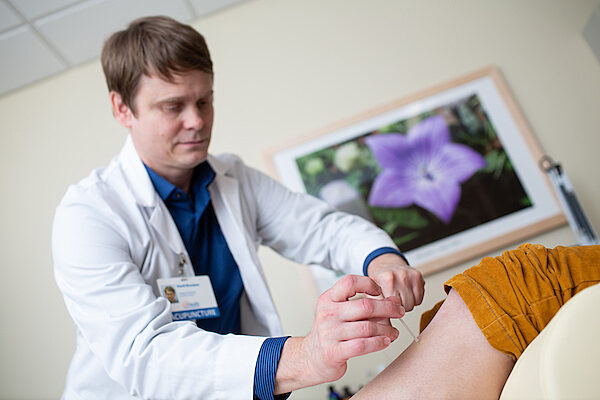Integrative Medicine: A partnership of conventional and holistic medicine
Integrative medicine may be an unfamiliar concept among patients and arguably an underutilized treatment option for an array of medical conditions. It is a…

Update your location to show providers, locations, and services closest to you.
Temporomandibular joint and muscle disorders (TMJ disorders) are problems that affect the chewing muscles and joints that connect your lower jaw to your skull.
TMD; Temporomandibular joint disorders; Temporomandibular muscle disorders; Costen's syndrome; Craniomandibular disorder; Temporomandibular disorder
There are 2 matching temporomandibular joints on each side of your head. They are located just in front of your ears. The abbreviation "TMJ" refers to the name of the joint, but it is often used to mean any disorders or symptoms of this region.
Many TMJ-related symptoms are caused by the effects of physical stress on the structures around the joint. These structures include:
For many people with temporomandibular joint disorders, the cause is unknown. Some causes given for this condition are not well-proven. They include:
Poor posture can also be an important factor in TMJ symptoms. For example, holding your head forward while looking at a computer all day strains the muscles of your face and neck.
Other factors that may make TMJ symptoms worse include poor diet and lack of sleep.
Many people end up having "trigger points." These are contracted muscles in your jaw, head, and neck. Trigger points can refer pain to other areas, causing a headache, earache, or toothache.
Other possible causes of TMJ-related symptoms include arthritis, fractures, dislocations, and structural problems present since birth.
Symptoms associated with TMJ disorders may be:
You may need to see more than one medical specialist for your TMJ pain and symptoms. This may include a health care provider, a dentist, or an ear, nose, and throat (ENT) doctor, depending on your symptoms.
You will need a thorough exam that involves:
Sometimes, the results of the physical exam may appear normal.
Your provider will also need to consider other conditions, such as infections, nerve-related problems, and headaches that may be causing your symptoms.
Simple, gentle therapies are recommended first.
Read as much as you can on how to treat TMJ disorders, as opinion varies widely. Get the opinions of several providers. The good news is that most people eventually find something that helps.
Ask your provider or dentist about medicines you can use. These might include:
Mouth or bite guards, also called splints or appliances, have long been used to treat teeth grinding, clenching, and TMJ disorders. They may or may not help.
If conservative treatments do not work, it does not automatically mean you need more aggressive treatment. Use caution when considering treatment methods that cannot be reversed, such as orthodontics or surgery that permanently changes your bite.
Reconstructive surgery of the jaw, or joint replacement, is rarely required. In fact, the results are often worse than before surgery.
You can get more information and find support groups through the TMJ Syndrome Association at www.tmj.org.
For many people, symptoms occur only sometimes and do not last long. They tend to go away in time with little or no treatment. Most cases can be successfully treated.
Some cases of pain go away on their own without treatment. TMJ-related pain may return again in the future. If the cause is nighttime clenching, treatment can be very tricky because it is a sleeping behavior that is hard to control.
Mouth splints are a common treatment approach for teeth grinding. While some splints may silence the grinding by providing a flat, even surface, they may not be as effective at reducing pain or stopping clenching. Splints may work well in the short-term, but could become less effective over time. Some splints can also cause bite changes if they are not fitted properly. This may cause a new problem.
TMJ may cause:
See your provider right away if you are having trouble eating or opening your mouth. Keep in mind that many conditions can cause TMJ symptoms, from arthritis to whiplash injuries. Experts who are specially trained in facial pain can help diagnose and treat TMJ.
Many of the home-care steps to treat TMJ problems can also help prevent the condition. These steps include:
Indresano AT, Park CM. Nonsurgical management of temporomandibular joint disorders. In: Fonseca RJ, ed. Oral and Maxillofacial Surgery. 3rd ed. St Louis, MO: Elsevier; 2018:chap 39.
Lee E, Crowder HR, Tummala N, Goodman JF, Abbott J, Zapanta PE. Temporomandibular disorder treatment algorithm for otolaryngologists. Am J Otolaryngol. 2021;42(6):103155. PMID: 34214714. pubmed.ncbi.nlm.nih.gov/34214714/.
Okeson JP. Temporomandibular disorders. In: Kellerman RD, Rakel DP, eds. Conn's Current Therapy 2022. Philadelphia, PA: Elsevier; 2022:522-525.
Pedigo RA, Amsterdam JT. Oral medicine. In: Walls RM, Hockberger RS, Gausche-Hill M, eds. Rosen's Emergency Medicine: Concepts and Clinical Practice. 9th ed. Philadelphia, PA: Elsevier; 2018:chap 60.


Integrative medicine may be an unfamiliar concept among patients and arguably an underutilized treatment option for an array of medical conditions. It is a…
